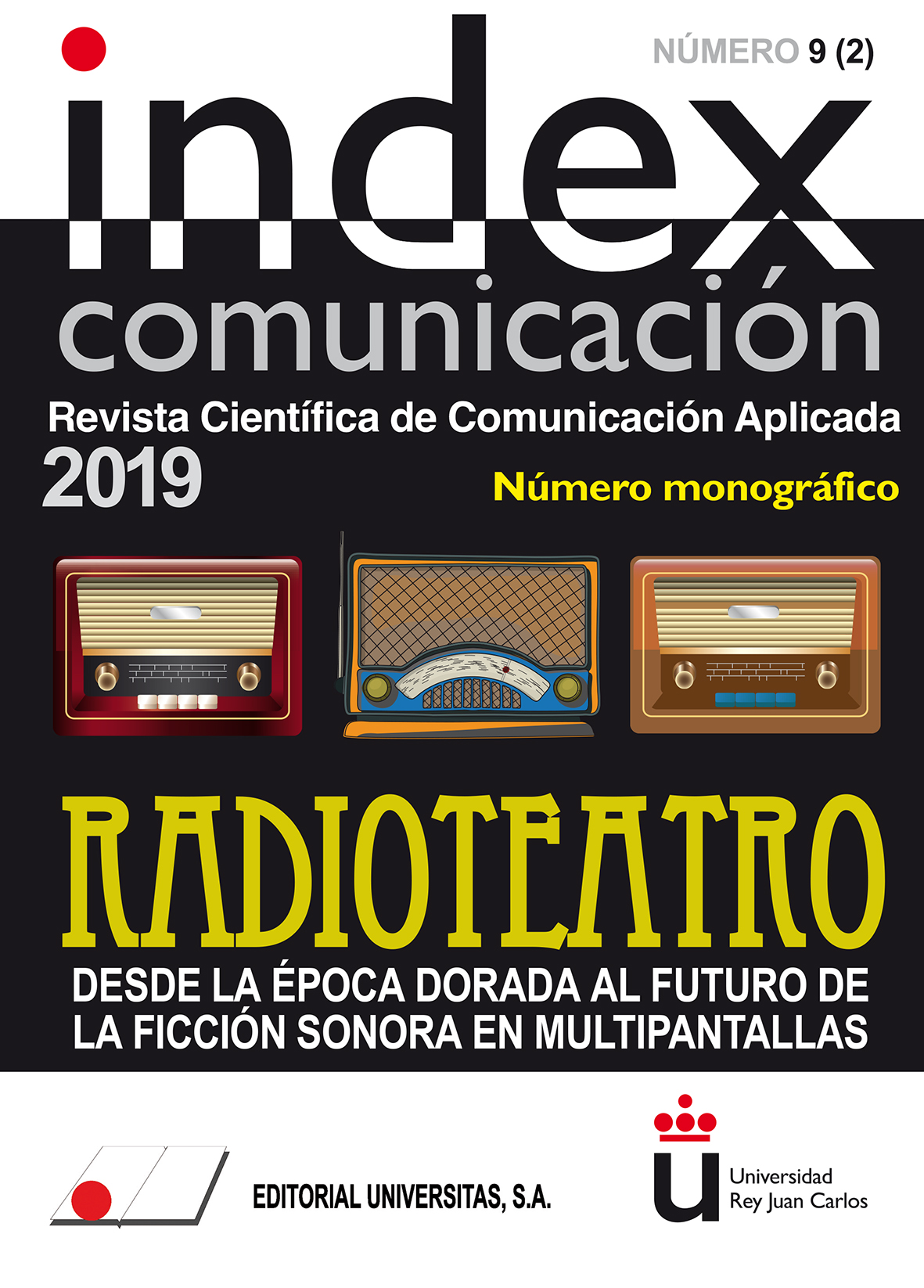Radio Drama in Spain: Context of Reference for a Diachronic Approach
DOI:
https://doi.org/10.33732/ixc/09/02ElradiKeywords:
Radio, Radio Drama, Radio Serials, Radio Soap Opera, Radio Fiction,Abstract
The main objective of this article is to give a contextualization of radio drama in Spain, over a period of three decades in the last century, between the 1940s and the 1970s. Through retrospective analysis on its history some of the keys related to narrative and drama genres implementation are assessed. The research methodology used can be classified as theoretical-conceptual, since it has been based on the search, compilation and analysis of documentation that have allowed radio theater to be contextualized in those three decades. As a result of the research, the relationship between radio plays and social context is revealed and the contributions of the main Spanish authors and directors of radio drama in those decades are referenced. The final conclusion points to the fact that radio drama throughout radio history has been appearing and disappearing conditioned by programmers and public demand. Despite this, even by the end of the seventies, when radio programmers stood up for informative content, some radio dramatic serials would continue in the radio programming: La Saga de los Porretas (Cadena SER) or Sobrenatural and Historias (RNE).Metrics
References
AGUILERA, M. y ARQUERO, I (2017). La ficción sonora y la realización en directo: el reto de RNE. Área abierta, 1(17), 117-146.
ARQUERO, I. (2015). De vuelta a la ficción sonora. Espéculo: Revista de estudios literarios, 54, 155-168.
ALCUDIA, M. (Coord.) (2008). Nuevas perspectivas sobre los géneros radiofónicos. Madrid: Editorial Fragua.
AYUSO, E. (2013). La recepción de la radio dramática en España (desde la posguerra a 1971). index.comunicación, 3, 167-185.
BALSEBRE, A. (1999). En el aire. 75 años de radio en España. Servicios Documentales de la Cadena SER. Promotora General de Revistas S. A.
BALSEBRE, A. (2001). Historia de la Radio en España. (1874-1939). Volumen I. Madrid: Ediciones Cátedra.
BALSEBRE, A. (2002). Historia de la Radio en España. Volumen II (1939-1985). Madrid: Ediciones Cátedra.
BAREA, P. (1994). La Estirpe de Sautier. La Época Dorada de la radionovela en España (1924-1964). Madrid: El País- Aguilar.
BAREA, P. (2000). Teatro de los sonidos, sonidos del teatro. Teatro radio-teatro, ida y vuelta. Bilbao: Universidad del País Vasco.
CEBRIÁN, M. (1996). La radio en la configuración de la cultura de masas hasta 1936. Revista Comunicación y Estudios Universitarios, 6. Valencia.
CUELLO, V. A. (2001). El radioteatro: herramienta educativa para alcanzar al público infantil. México: Instituto Latinoamericano de la Comunicación Educativa.
DÍAZ, L. (1993). La radio en España (1923-1993). Madrid: Alianza Editorial.
FAUS, Á. (2001). Reinventar la radio. Chasqui, Revista Latinoamericana de Comunicación, 74. Ecuador.
FAUS, Á. (2007). La radio en España (1896-1977). Madrid: Ed. Taurus.
FERNÁNDEZ, J. L. (2008). La construcción de lo radiofónico. Buenos Aires: La Bujía.
GONZÁLEZ, M. J. (2008). La radio. El sonido de la supervivencia. Madrid: Universitas
GUARINOS, V. (1999). El teatro radiofónico. Una narración radiofónica inaudible. Tesis doctoral. Universidad de Sevilla.
GUARINOS, V. (2009). Manual de narrativa radiofónica. Madrid: Editorial Síntesis
HAYE, R. (1995). Hacia una nueva radio. Buenos Aires: Paidós.
KAPLÚN, M. (1978). Producción de Programas de radio. El guión, la realización. Quito: Colección CIESPAL.
KAPLÚN, M. (1981). Un taller de radiodrama: Su metodología, su proceso. Quito: Colección CIESPAL.
MARTÍNEZ-COSTA y DÍEZ, J. R. (2005). Lenguaje, géneros y programas de radio: introducción a la narrativa radiofónica. Pamplona: EUNSA.
MERAYO, A. y PÉREZ, C. (2001). La magia radiofónica de las palabras. Salamanca: Librería Cervantes.
MUNSÓ, J. (1988). Escrito en el Aire. Madrid: RTVE.
NIETO, M. A. (2005). Bobby Deglané, el arquitecto de la radio española. Barcelona: Ediciones B.
ORTIZ, M. A. y Volpini, F. (1995). Diseño de programas en radio. Barcelona: Edit. Paidós Papeles de Comunicación 11.
ORTIZ, M. A. y VOLPINI, F. (2017). Realización, lenguaje y elecciones narrativas de radioteatro: tres aproximaciones a la creación de espacios sonoros en el tiempo. Área Abierta, 1(17), 1, 13 -36.
PACO, M. de (2010). El teatro de los Hermanos Quintero. Universidad de Murcia. Murcia: Edit.um.
REIG, R. (2011). Los dueños del periodismo. Claves de la estructura mediática mundial y de España. Barcelona: Gedisa.
RODERO, E. (2004). Clasificación y caracterización de los géneros radiofónicos de ficción: los contenidos olvidados. En MÍNGUEZ y
VILLAGRA (Coord.). La comunicación, nuevos discursos y perspectivas. Madrid: Edipo, pp. 145-154.
RODERO, E. (2005). Recuperar la creatividad radiofónica. Razones para apostar por la radio de ficción, Análisi, 32, 133-146.
RODERO, E. y Soengas, X. (2010). Ficción Radiofónica. Madrid: Instituto Radiotelevisión Española.
SOENGAS, X. (2013). Retos de la radio en los escenarios de la convergencia digital. adComunica, Revista de Estrategias, Tendencias e Innovación en Comunicación, 5.
VÁZQUEZ, E. (2004). Matilde, Perico y Periquín. Madrid: Editorial Edaf.
Published
How to Cite
Issue
Section
License
Copyright (c) 2019 María Julia González Conde, Miguel Ángel Ortiz-Sobrino , Hugo Prieto-González

This work is licensed under a Creative Commons Attribution-NonCommercial 4.0 International License.
Authors who submit to this journal agree to the following terms:
Authors retain copyright and ensure the magazine's right to be the first publication of the work as licensed under a Creative Commons Attribution-NoComercial 4.0 International License that allows others to share the work with an acknowledgment of authorship of the work and the initial publication in this magazine, with no commercial purpose.
Authors can establish separate additional agreements for non-exclusive distribution of the version of the work published in the magazine (for example, to an institutional repository or publish it in a book), with an acknowledgment of its initial publication in this journal.
It allows and authors are encouraged to disseminate their work electronically (eg, in institutional repositories or on their own website) prior to and during the submission process, as it can lead to productive exchanges, as well as a citation more early and most of the published work (See The Effect of Open Access).















